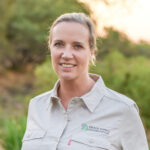Peace Parks Foundation’s Chief Development Officer, Lilian Spijkerman, is staying at the magical Zambian Horseback Safaris in the Simalaha Community Conservancy. After soaking up the sights of the grassy floodplains bathed in the golden morning light, she joins a group of donors from the Dutch non-profit organisation, DOB Ecology, to take to the skies to get a bird’s-eye-view of this remarkable landscape.
Wildlife in Numbers
As they fly across Simalaha’s wildlife sanctuary, Lilian and the team spot large herds of wildebeest, giraffe, puku and red lechwe. In an area that was once denuded of wildlife, seeing healthy herds of wildlife is a fantastic reminder of just how far the conservancy has come since Peace Parks Foundation assisted with the first animal translocation in 2013.
A Protected Landscape
These animals are now protected by Simalaha’s dedicated wildlife scouts, who are all members of the local communities. Carrying out regular patrols throughout the sanctuary has helped to create a thriving wildlife economy which has already benefitted the local people through tourism income as well as contributed to transfrontier conservation at large by maintaining a healthy environment. This helps Peace Parks in their mission to secure large functioning ecosystems that our planet relies on for survival.
You can find out more about Simalaha’s wildlife guardians here.
Life-sustaining Floods
The helicopters continue to swoop over the floodplains below and as the annual floodwaters have been receding, forming narrow waterways that crisscross the landscape. Although the floods can make life difficult for the local people and tourism operators, it is an important source of life, vital for depositing nutrient-rich sediments and minerals into the sun-baked soil. When the waters begin to recede, the groundwater increases and the soils become more arable, which aids the local farmers and it helps to remove invasive vegetation from the grasslands.
Peace Parks Foundation and partners have supported the people here since its establishment and continue to help foster a future where communities and nature can thrive in harmony.


